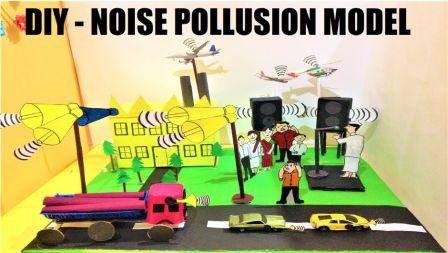Introduction
Noise is measured in Db (decibels) for the normal human ears any sound levels less than 70 Db are less damaging to the living organisms.

If any sound goes beyond the 70dB then it needs to treat as noise pollutions due to impacts the living beings as well adverse effect in humans and animals.
Making a noise (sound) pollution project model is a great way to illustrate the sources and effects of noise pollution in a visual and interactive manner.
Here’s a step-by-step guide to making this model using cardboard, paper, speakers, and a horn:
Materials Needed:
- Cardboard
- Color paper
- Scissors or craft knife
- Glue (hot glue gun or white glue)
- Markers, crayons, or paint
- Small speakers (you can use old earphones or small Bluetooth speakers)
- Horn (a small toy horn or a paper model)
- Battery (if needed for the speakers)
- Wires (if using wired speakers)
- Decorative items like small toy cars, trees, and buildings (optional)
- Cotton balls (to simulate smoke or sound waves)
Detailed Step By Step Video Show How To Make Noise Pollution’s Model
Step 1: Prepare the Base
- Cut the Base:
- Cut a large piece of cardboard to act as the base for your model. Ensure it’s sturdy enough to hold all the elements you plan to add.
- Create the Ground:
- Cover the cardboard base with color paper or paint it to represent the ground. You can use gray or brown paper for roads and green for parks or residential areas.
Step 2: Build the Structures
- Factories:
- Cut and assemble small box shapes from cardboard to represent factories. Cover them with color paper and decorate with markers to add windows and doors. Attach small cotton balls on top to simulate smoke.
- Vehicles:
- Cut out shapes of cars, trucks, and buses from cardboard or color paper. Decorate them with markers or paint. Glue small toy wheels or draw wheels on them.
- Buildings:
- Create small cardboard buildings and cover them with color paper. Decorate them with windows, doors, and other details using markers.
Step 3: Create Noise Sources
- Speakers:
- Place small speakers inside or near the factory buildings and vehicles. If using wired speakers, ensure the wires are securely attached and hidden as much as possible.
- Horn:
- If you have a toy horn, place it near a vehicle. Alternatively, create a horn using paper:
- Roll a small piece of paper into a cone shape and secure it with glue.
- Attach the cone to the front of a vehicle or a factory to simulate a loud horn.
- If you have a toy horn, place it near a vehicle. Alternatively, create a horn using paper:
- Simulate Noise:
- Use small pieces of cotton balls around the speakers and horn to simulate sound waves.
Step 4: Assemble the Model
- Arrange the Structures:
- Arrange the factories, vehicles, and buildings on the cardboard base to create a small cityscape. Ensure there’s a mix of industrial, residential, and recreational areas.
- Add Details:
- Use markers or paint to add roads, sidewalks, and green spaces.
- Add small toy trees, people, or animals to make the scene more realistic.
Step 5: Wiring and Testing
- Connect Speakers:
- Connect the small speakers to a power source (battery) if needed. Ensure they are securely in place and can emit sound when turned on.
- Testing:
- Turn on the speakers and horn to demonstrate the noise pollution. You can play sounds of factory noise, traffic, or honking horns through the speakers to make the model interactive.
Noise Pollution model Explanation:
This model illustrates the various sources and impacts of noise pollution in a typical urban environment.
- Factories: Represent industrial areas that produce loud machinery noises. Cotton balls simulate the smoke and sound waves.
- Vehicles: Cars, trucks, and buses contribute to noise pollution with engine noise and honking horns.
- Buildings: Residential and commercial buildings affected by nearby noise sources.
- Speakers and Horn: Small speakers and a toy horn are used to simulate the actual noise produced by these sources. When turned on, they provide a real-time experience of noise pollution.
Noise Pollution model Explanation::
- Noise Pollution: Refers to unwanted or harmful noise from various sources that can affect human health and environmental quality.
- Effects on Health: Prolonged exposure to loud noise can lead to hearing loss, stress, sleep disturbances, and cardiovascular issues.
- Environmental Impact: Noise can disrupt wildlife, affecting animal communication, reproduction, and navigation.
This model helps us understand the sources of noise pollution and its impact on urban life. By visualizing and hearing the noise, we can better appreciate the importance of controlling noise pollution for healthier living conditions.”
By following these steps, you can create an engaging and educational noise pollution project model that visually and audibly demonstrates the impact of noise pollution.
Refer the resources/tools page section to find out where you buying it at reasonable cost.
Questions & Answers
What is the Major source of noise pollution
vehicle horns, mike set, loudspeakers

